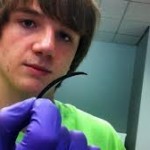Teenager invents cheap and highly selective cancer diagnostics test

If you’re feeling anxious about how U.S. kids lag the world in science and math, read this story of a high school teenager from Maryland who came up with a prize-winning breakthrough that could change how cancer and other fatal diseases are diagnosed and treated.
15 year old teenager Jack Andraka may have revolutionized cancer diagnostics [i]. Andraka has invented a pancreatic cancer test that is 168 times faster and considerably cheaper than the current testing standard in the field: a paper test strip that uses minute changes in conductivity to detect targeted viruses or antigens faster, cheaper and more accurately than today’s standard diagnostics.
To read the full article, please login. The full content of this article and all premium articles is available exclusively for site members.
Site membership is free. If you are an existing user, please login. New users may register below.



